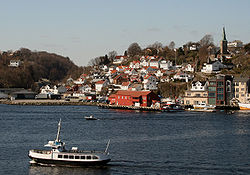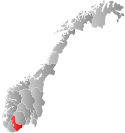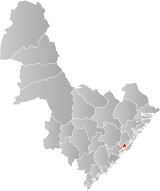Barbu, Norway
Barbu Municipality Barbu kommune | |
|---|---|
 View of Barbu | |
 Aust-Agder within Norway | |
 Barbu within Aust-Agder | |
| Coordinates: 58°27′59″N 08°46′41″E / 58.46639°N 8.77806°E / 58.46639; 8.77806 | |
| Country | Norway |
| County | Aust-Agder |
| District | Østre Agder |
| Established | 1 Jan 1878 |
| • Preceded by | Østre Moland Municipality |
| Disestablished | 1 Jan 1902 |
| • Succeeded by | Arendal Municipality |
| Administrative centre | Barbu |
| Area (upon dissolution)[1] | |
| • Total | 15.3 km2 (5.9 sq mi) |
| Population (1902) | |
| • Total | 6,787 |
| • Density | 440/km2 (1,100/sq mi) |
| Time zone | UTC+01:00 (CET) |
| • Summer (DST) | UTC+02:00 (CEST) |
| ISO 3166 code | NO-0990[2] |
Data from Statistics Norway | |
Barbu is a former municipality in the old Aust-Agder county in Norway. Today, it is part of the is part of the town of Arendal in Agder county. The 15.3-square-kilometre (5.9 sq mi) municipality existed from 1878 until 1902 when it was merged into the town of Arendal. The municipality was located just to the north of what was then the 0.34-square-kilometre (84-acre) town of Arendal. The administrative centre of the small, urban municipality was called Barbu as well. Barbu Church was the church for the municipality.[3]
Today, the name Barbu refers to the village-like place located in head of the Galtesundet strait within the town of Arendal. Barbu is also a parish (sogn) in the Arendal prosti (deanery) within the Diocese of Agder og Telemark.[1]
History
Originally, Barbu was a part of the municipality of Østre Moland that was created on 1 January 1838 (see formannskapsdistrikt law). On 1 May 1878, Østre Moland was divided to form three municipalities: Barbu (population: 4,874), Østre Moland (population: 2,524), and Tromøy (population: 2,320). On 1 January 1902, Barbu was merged with the neighboring town of Arendal, vastly increasing the size of the town. Before the merger, Barbu had a population of 6,787.[4]
Name
The municipality (originally the parish) is named after the old Barbu farm (Old Norse: Berubú). The first element is likely derived from the female name Bera. Another theory is that the first element is the old name for a local river. The last element is bú which means "dwelling" or "farm".[5]
Government
During its existence, this municipality was governed by a municipal council of directly elected representatives. The mayor was indirectly elected by a vote of the municipal council.[6]
See also
References
- ^ a b Kiær, Anders Nicolai; Helland, Amund; Vibe, Johan; Strøm, Boye (1904). "Arendal by". Norges land og folk: Nedenes amt (in Norwegian). Norway: H. Aschehoug & Company. p. 26. Retrieved 29 November 2017.
- ^ Bolstad, Erik; Thorsnæs, Geir, eds. (26 January 2023). "Kommunenummer". Store norske leksikon (in Norwegian). Kunnskapsforlaget.
- ^ Thorsnæs, Geir, ed. (21 June 2015). "Barbu – tidligere kommune i Aust-Agder". Store norske leksikon (in Norwegian). Kunnskapsforlaget. Retrieved 29 November 2017.
- ^ Jukvam, Dag (1999). "Historisk oversikt over endringer i kommune- og fylkesinndelingen" (PDF) (in Norwegian). Statistisk sentralbyrå. ISBN 9788253746845.
- ^ Rygh, Oluf (1905). Norske gaardnavne: Nedenes amt (in Norwegian) (8 ed.). Kristiania, Norge: W. C. Fabritius & sønners bogtrikkeri. p. 96.
- ^ Hansen, Tore; Vabo, Signy Irene, eds. (20 September 2022). "kommunestyre". Store norske leksikon (in Norwegian). Kunnskapsforlaget. Retrieved 1 January 2023.
External links
 Arendal travel guide from Wikivoyage
Arendal travel guide from Wikivoyage
- v
- t
- e
- Main article: Agder
- Capitals: Kristiansand; Arendal
- County government: Agder County Municipality
- County lists:

- Arendal (1610)
- Grimstad (1622)
- Risør (1630)
- Kristiansand (1641)
- Flekkefjord (1660)
- Mandal (1779)
- Farsund (1795)
- Lillesand (1830-1961; 1996)
- Tvedestrand (1997)
- Lyngdal (2001)
| Østre Agder | |
|---|---|
| Setesdal | |
| Kristiansand | |
| Lister and Mandal |
| |||||||||












